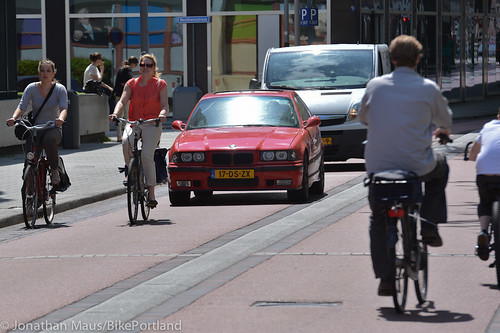
(Photos J. Maus/BikePortland)
Tonight in northeast Portland, the Bureau of Transportation will share their draft staff recommendation for the 20s Bikeway project. We’ll be there to see what their latest thinking is and — like everyone else — we’ll be especially interested to see what they have in mind for the segment of SE/NE 28th Avenue between Stark and Sandy. That’s the commercial district that has become the subject of a debate between auto parking and a dedicated bikeway.

In an interview with BikePortland last week, PBOT Director Leah Treat called the 20s Bikeway, “… probably one of the most controversial projects we’ve proposed in the last several years.”
But what if there was another way to approach the design? One that would improve the bicycling experience, while not leading to a major fight over parking? I’m thinking of something like the “bicycle street” design I saw in Rotterdam last summer. I’ve mentioned it in comments a few times, but I figured with PBOT getting closer to a design recommendation it’d be worth a bit more focus.
On Teilingerstraat in Rotterdam, people in cars behave as “guests” and people riding bikes position themselves in the middle of the lane without feeling threatened or stressed. Signs at the entrances to this particular segment of the street read: “Bike street: Cars are guests.” There are also design elements that accompany the sign: a red-colored roadway (standard for bikeways in Rotterdam) and a ramped curb center median. There was also a max speed of 18 mph.
Here’s a view via Google streetview:
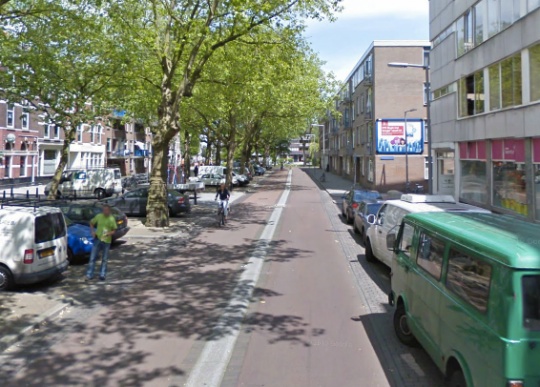
And a few more photos from my 2013 visit:
Similar to 28th between Stark and Sandy, this section of Teilingerstraat is a popular bikeway but it doesn’t have dedicated space for cycling. Instead, all road users simply share the space.
I was amazed at how this design worked. Drivers simply motored along at a courteous distance and speed while bicycle riders pedaled comfortably in front of them. Everyone understood the rules. I can’t help but wonder whether this type of design would work on 28th and other commercial district streets in Portland.
Of course, the design context in the Rotterdam street is much different. 28th Avenue has a much higher automobile traffic volume than Teilingerstraat. As pointed out to us by planner and regular commenter Nick Falbo back in February , “… that street in Rotterdam is not carrying 7,000 cars per day… the Rotterdam design would break down at 28th’s traffic levels.”
Nick is right. 7,000 average auto trips per day is well over twice the volume PBOT would feel comfortable with in designing for a shared environment (like they do on neighborhood greenways).
But I would counter his point by saying the the goal of road design in a dense business district should be just as much about quality of space as it is about volume and pace. In other words, what would be so bad about simply slowing people down? Isn’t it better for business to give people more time to see storefront signs and windows? And the slower speeds and traditional lane use in this design would make for a much safer and predictable walking environment.
Another issue with this design is that sharing the same space with auto users runs counter to the popular premise that the “interested but concerned” category of riders must have protected bike lanes.
From a PBOT engineering and planning standpoint, fear of trying this design on a busier street like 28th is that cars would back up and clog intersections, and many people might get frustrated with the slower speeds and opt for adjacent residential streets instead. I acknowledge that possibility; but I also know that by improving conditions for bicycling, the auto trip volume will eventually go down as more people make the switch.
At some point we have to stop being afraid of catering to existing behaviors to the detriment of our adopted planning goals and quality of life. This design is also appealing to me because it doesn’t carry the same “war on cars” political costs. Like many cities in the Netherlands have figured out, there’s no reason to be anti-car, you simply try to beat cars at their own game and everything will work itself out.
I’d love to hear what you think about this concept and whether or not it could ever work here in Portland.
(Stay tuned for a full report from tonight’s 20s Bikeway Stakeholder Advisory Committee meeting.)


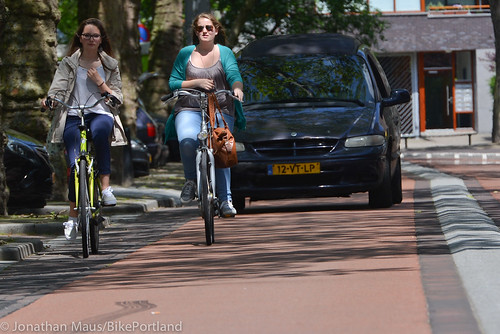
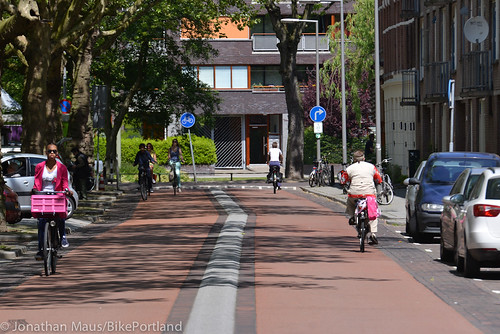
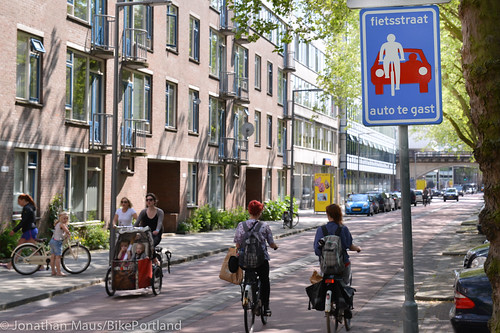
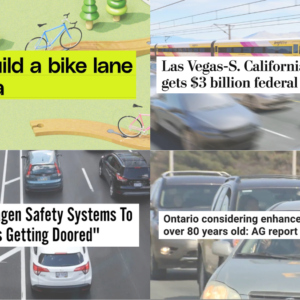

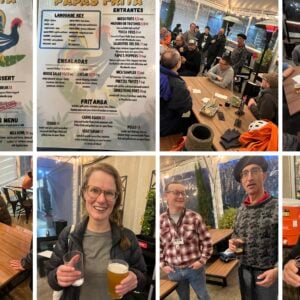
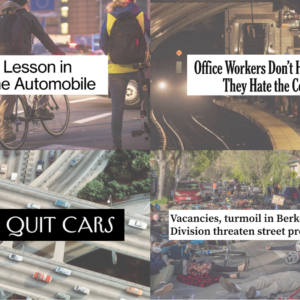
Thanks for reading.
BikePortland has served this community with independent community journalism since 2005. We rely on subscriptions from readers like you to survive. Your financial support is vital in keeping this valuable resource alive and well.
Please subscribe today to strengthen and expand our work.
I saw this same treatment frequently in the rural south of the Netherlands (Vlissingen region) during my 2009 study tour. It works well with lighter faster traffic and low bike volumes. I have NOT yet seen applied to a urban area so this will be interesting to track. More typical for urban streets is the advisory bike lane with center bidirectional shared car lane …we have been talking about for 10+ years. The adoption of the 20mph speed limit is good, but still not good enough (we needed 15 mph) for streets with temporal space sharing and gap giving.
The use of this type of mountable mini median would also require the City to administratively adopt a new snow management policy for the route: avoiding plowing but adding more pretreatment (deicer).
I think it there are several locations it could work. Lower volume neighborhood collectors with good alternate through routes for non-local traffic. Alberta in the 30’s, Ainsworth, Greeley to 37th; N Mississippi?; N Lombard, St Louis to Richmond. Any location shop owners might want that relaxed, environment that promotes an active street. Also, this might work well in NW on the future greenways like Raleigh, Pettygrove, Marshall or 24th. 25th might work if the goal is to move traffic to 23rd, though it’s pretty congested already.
The problem on streets like NE 28 without room for separated infrastructure is, again, not the space itself but rather the perceived “right of speed” of people behind the wheel of an automobile.
People in cars in this country seem to think that driving up to and over the speed limit is some sort of natural law and anything that stops them from doing that is the wrong.
Reframing cars to make them the “guest” on urban streets sounds like a good thing to me.
I think it is a great suggestion.
One more (dynamic) reason to consider something bolder is that the present volume of cars encountered on any stretch of road, including this one, is bound to decline. Some regulars here find my frequent invocation of the future decline of autodom unlikely or downright fanciful, but I don’t think we’ll have to wait too long to find out who’s right.
So you may not drive… but think about how our goods gets shipped, how our goods gets manufactured, and how we heat our buildings. I think you’ll find in your doomsday scenario that you aren’t so “immune” to any sudden and prolonged shock in oil and gas prices as you lead yourself to believe. In fact, you should fret over the collapse of our society if it ever gets to that point.
I never claimed to be immune, nor do I take any special pleasure in our infrastructure and way of life drying up and blowing away. My point is to consider the possibility (to fret seems less constructive). I think we’re not so far apart.
Thanks for introducing “right of speed” as a concept for discussion. I think severely lowering speed is the best solution for 28th. Everyone should enter those blocks without a sense of entitlement for their mode (car, bike, foot). The problem of course is that so many people who drive (and many who ride) have a “don’t you dare make me slow, I gotta go go go” attitude when in fact, the actual delay in getting to one’s destination because of the inconvenient appearance of a rider or pedestrian can be measured in seconds. There’s no logic to it, it’s all about attitude and expectation and my “right of speed”.
we have a few of these in the Boston area – the signage is “bikes allowed full use of lane” which are on one-way streets, and they sometimes have contra-flow bike lanes. They work to a varying degree – most of the time motorists are courteous, but occasionally you’ll get insane honking and yelling by motorists.
although – I think a big part of the the reason things like that work around here is that jaywalking is essentially decriminalized ($1 fine), and “jay-biking” is at most a $20 offense, so police mostly enforce motorist behavior rather than going after vulnerable road users.
in case you’re wondering – here’s downtown crossing in Boston – cars can go through there (except certain times of the day), but people can (and do) walk in the middle of the street at all hours. The area also has a good amount of bike traffic – I think daily counts are around a thousand or so – but nowhere near pedestrian volumes.
https://maps.google.com/?ll=42.354914,-71.059716&spn=0.002379,0.005048&t=h&z=18&layer=c&cbll=42.354914,-71.059716&panoid=b5YUxaXfS3i3lT2neYLMNw&cbp=12,299.09,,0,4.59
and here
https://maps.google.com/?ll=42.354968,-71.061577&spn=0.002379,0.005048&t=h&z=18&layer=c&cbll=42.354776,-71.061206&panoid=DIuGR-z5vhglHiKExwFLZg&cbp=12,37.86,,0,10.35
Holy Monkey Trumpets! I lived in Boston in the early 2000s and I was one of the only crazy people on a bike there. By far the least friendly place to ride that I’ve lived in. Things sure have changed, for the better. If only Portland still had the momentum that Boston seems to have now…
Sure, this could work anywhere in the US.
All you need to do is remove the aggressive, impatient and domineering “NOTHING CAN GET IN MY WAY!!!” attitude of American drivers.
Solve that little problem and everything will be peachy.
Punitive penalties. Over time, those people will either change, or they will stay away from Portland.
Self driving cars and obscenely high(*) per mile insurance rates for drivers that insist on driving manually.
Public roads are a tacit agreement that the costs of transportation are lowered greatly when everyone works together for facilities that don’t resemble stories from Grimm’s Fairy the Tales. This amortization does not require us to subsidize people’s poor driving skills.
(*) recoup ALL costs of a collision like: repair, clean up of the public road of debris and toxins, medical, rehabilitation, disability until everyone and everything is as it once was before the incident.
Sadly, I concur with q’Tzal on this one. The American psyche, with its up-by-the-bootstraps, me-first approach, is embedded too deeply in our transportation history to ever have such a considerate, European model be successful here. And that is why I have largely given up on slogans like “Share The Road” in my transportation thinking and philosophy. Such slogans distract people from the real issues behind how and why we design our cities, and why too many of us are just too American to ever effect meaningful, large-scale change in our infrastructures.
I think the only way we will ever see real, significant change is for the Peak Oil scenarios to finally come true. Not that I look forward to living in such a world, because the transition will be hell for everyone; but anymore that is where my hunches are pointing me.
I think it could work and should be tried.
We are talking about a very short stretch of 28th that is a dense commercial district. Just ten blocks from Stark to Glisan. Maybe even just five blocks from Burnside to Glisan.
Car speeds here are already on the low side, typically 20-25 mph, and a cyclist can already ride this entire stretch in the center of the lane at 15 mph and expect that, most of the time, the drivers behind will stay follow politely or at least resignedly. Source: personal experience, I ride this stretch at least 3 days a week on my way home from work. So existing behavior is not so terribly far from the goal.
How to do it:
– Curb bulges and center medians. Threading through narrow spots slows drivers down, medians prevent drivers from passing a bike in the lane.
– Intersection flashers, marking, pavement coloring, and lots of explicit signage. “Cars Slow For Bikes” and so on. Drivers will realize they are on a different kind of street.
– Signal timing at 15 mph. Speed limit consistent with the desired use.
– Speed displays and (visible) cameras. Drivers follow the rules more closely when there is the threat of enforcement.
If it works, the businesses can keep the parking, cyclists will have the freedom of using the whole street, and drivers will still be able to use this stretch of 28th – but if they are in a hurry, they’ll learn to use 39th or 20th.
Bigger picture: I don’t think the future of bike mode in Portland is lots of separated cycletracks running all through the city. The reason I’m confident of that is money. The city doesn’t have the budget to build a hundred mile network of separated cycletrack, not now and not in 20 years. It may have the budget to build 20 or 30 miles of separated cycletrack on the roads with greatest need. So . . . what are we going to do about the other roads? We have to figure out how to change driver behavior so that cars and bikes can co-exist more safely. This ten block stretch of road can be an experiment.
If it doesn’t work, the fallback can be to remove parking and stripe bike lanes.
I agree with you except that if doesn’t work, the city will also be tearing out the expensive curbs extensions and center medians. Maybe those should temporary?
Temporary curbing costs up to $45/foot, so about $9k per block. More to install than permanent curb, but much easier to remove if things go south, and reusable elsewhere. If we started with the low middle curb and denser sharrows, it would be low cost to test. PBOT could even do shorter segments as test sections.
Taking the full lane on 28th is currently the safest way to approach riding this stretch anyway. Especially between Burnside and Sandy. I think that “autos as guests” signage and a reduced speed limit could be enough to make this work.
Great blog post.
“…Car speeds here are already on the low side, typically 20-25 mph, and a cyclist can already ride this entire stretch in the center of the lane at 15 mph …” John Liu
That a 15 mph travel speed is being accepted on a 20-25 mph street is a great point, and for a five or ten block length of street, would likely be no big deal, if people just determined that they were going to ride the street at that speed or somewhat faster. It seems to me that traffic flowing with little interruption, is desired more by road users, than traffic flowing consistently at certain peak high speeds.
If some people riding believe they should have infrastructure on the street that allows them to travel much slower, such as the 5mph that Trek3900 rather sarcastically notes in his comment below, that could be a problem.
“the goal of road design in a dense business district should be just as much about quality of space as it is about volume and pace. In other words, what would be so bad about simply slowing people down? Isn’t it better for business to give people more time to see storefront signs and windows? And the slower speeds and traditional lane use in this design would make for a much safer and predictable walking environment.”
GIVE THAT MAN A MEDAL. Well said, Jonathan — a great way to plan for benefiting both people and businesses. (Now if businesses would only see it that way. It never fails to amaze me that businesses think cars flying by at 40 mph are *more likely* to see their shop.)
If you want this vision to ever be possible on 28th, it behooves you to get involved to the TSP process, especially when decisions are being made on roadway functional classifications.
28th is currently classified as a neighborhood collector and major emergency response street in the TSP, and therefore emergency service access requirements preclude traffic calming and diversion on this street. Without these enhancements, speeds and volumes won’t be low enough to make this work.
TSP policy on traffic calming along Major Emergency Response Streets:
“Traffic Slowing: Major Emergency Response Routes are not eligible for traffic slowing devices in the future. Existing traffic slowing devices may remain and be replaced if necessary.”
On another note, here’s what the TSP says about on-street parking along Neighborhood Collectors:
“On-Street Parking: The removal of on-street parking and right-of-way acquisition should be discouraged on Neighborhood Collectors.”
Ha.
With friends like these….
Didn’t some official say recently that the EMT’s could live with 28th taken out as a response corridor?
And honestly, I’d think emergency responders would like more bikes on the response corridors, bikes are easier to get around and can stop and pull over faster than a car in traffic.
And it’s not as if auto traffic makes much of an effort around here to clear a path for the response vehicles.
The TSP is coming up for revision and ER routes are likely to increase, not decrease. PBOT is testing fire friendly speed cushions on NW Cornell and SW 51st, so hopefully there will be new options for traffic calming ER routes in the future. Some of the safe routes reports have mentioned this future possibility. Any street that crosses a major barrier, like a freeway, like 28th does, becomes a route for emergency response because it is one of the few streets to cross the barrier.
This has been tried. Doesn’t look like it works at anything approaching that sort of business, even in the Netherlands:
http://www.aviewfromthecyclepath.com/2014/04/shared-space-revisited-hype-continues.html
Nice attempt, but seems like a bad idea…
I liked this line:
“A mainly young adult male demographic and wearing helmets and reflective clothing is an indication of very low subjective safety. In the Netherlands, cyclists do not look like that…”
When I first saw this street design in one of the Bike Portland’s previous posts, I immediately thought it would be a perfect design for NE Alberta and N Mississippi. Both streets already have huge numbers of pedestrians and slowed traffic due to all of the activity. Neither one is a major collector either. Why not take it a step further and make them the ideal mixed mobility use business district. At the very least, take out the center line in the street.
I’m pretty much in the fearless (but really I’m cautious) category. I’ve never been afraid to take a lane even on busier streets, and honestly I feel safer in the middle or left hand side of a lane where my position is directly in front of drivers – where I know they are actually looking. Though I admit at first it takes getting use to it.
All the infrastructure we need is already there.
I don’t see why shared roads aren’t in place to begin with. Especially in areas where the speed limit is 25 or less. Traffic control devices are programmed to keep traffic moving steady at less than the speed limits. Slower speed make everyone safer. And at rush hour most the major roads are moving slower than the posted speed limits anyway.
So lets just be done with all of it and reduce existing speed limits by 20%. Any road with a speed limit of less or equal to 25 mph it opened up to cyclists. Think about it, no more bike lanes, no more doorings, no loss of parking, safer streets for all users. Everyone wins.
I admit I feel for the whole separate facilities for different modes of transportation for awhile. It’s easy to fall for, especially if you buy into the whole riding a bike is dangerous B.S. it’s not, in fact it is the safest mode of individual transportation- bar none. More people ride bikes over the Hawthorne Bridge in a busy month than are killed AND injured on bicycles across the whole country in a year.
But really it’s this demand for segregation of facilities that causes much of the uproar with the non bike riders. Segregation of anything never really works well for anyone. Equal access to the roads with slower speed limits eliminates much of the arguments against the “bike lobby”, And those funds that are used for bike lanes, stripes, greenways etc… can be used for maintaining the roads and intersections (protecting the weakest-pedestrians- protects all).
Why shouldn’t the roads be like they were pre 1990s when all this bike infrastructure was starting to be pushed? Of course, that is a decade after the helmet laws started kicking in, which is what made everyone think that riding a bike is an inherently dangerous activity. And they (helmets) actually did make it more dangerous-if you think otherwise you need to do your research.
Cars and bikes co-existed on the same roads relatively peacefully for nearly 80 years before all that.
agree with one caveat: for this to work, we need enforcement (with actual penalties) of speed limits, aggressive driving, distracted driving, and red light running
Enforcement would definitely be a priority. And why am I saying would, it should be a priority….and it should be now.
Which is exactly why this will NOT work in Portland. If you think you will need better enforcement to make a piece of infrastructure work, then it’ll likely fail, because you can’t put police there 24/7 to make people behave. If you could, you wouldn’t need fancy pavement or curbs, or whatever, because sharrows and the like would be sufficient.
Something like this might work on a street with very high levels of people on bikes (through route) and very low levels of cars (NO through route), in combination with a low speed level and built-in devices to force cars to slow down (such as tight corner radii). Go build cycle paths along the main through routes first, divert cars away from residential streets by limiting their through routes and lowering speed limits, and if you’ve racked up the bike mode share up to, say, at least 20%, THEN experiment with shared space-like concepts like this.
Looks pretty stupid to be going what looks like 5 mph on your bike while a car rolls along 5 feet behind you. Inconsiderate of the bikers at best.
I love this. In my daily ride I use SW Broadway (bike lane, door zone, right hooks etc) on my way to work and SW 10th Ave (taking the lane in the center lane) on my way home. Because 10th is slightly downhill I can always ride with the flow of traffic and rarely feel any danger. Every day on SW Broadway is like riding the gauntlet and at times is extremely dangerous. If the speed limit is lowered and the expectation for drivers is that there will be bikes and pedestrians, it seems that this short stretch of road would be one of the most enjoyable in the city for all users. I love it and would like to see this approach taken in other areas.
“At some point we have to stop being afraid of catering to existing behaviors to the detriment of our adopted planning goals and quality of life.” You’ve hit the nail on the head, Maus.
Jonathan, you’ve been writing about these shared roads for awhile, and I keep mulling over the idea. It seems to solve the current impasse we’ve reached with road design:
* Attract the ire of business owners if you remove parking
* Can’t attract new bikers if you don’t have a separated lane – which requires removing parking
* Can’t put in physical traffic calming measures without raising a problem with emergency vehicle access
* Irritate homeowners if you redirect traffic from a main throughway to a side street
* Oh, and the budget for road changes is basically nil
So the shared streets seem to sidestep ALL those issues and say – look, cars can get through, cars can park, bikers can feel safe, bikers can actually get to your business, AND emergency vehicles aren’t effected.
So shared streets, then, become an issue of regulation and enforcement. But thankfully, a shared street would just have ONE simple rule:
**All traffic must move at the speed of the slowest user of the road at that time**
–which, of course, includes pedestrians. It’s an idea that dovetails nicely with Vision Zero, because it’s putting the most vulnerable road user in control of traffic flow.
So let’s throw some crazy bright paint on a stretch of road like 28th, put up a bunch of signs, and see how it goes. It’s a cheap enough plan to experiment with, basically, immediately.
(And if it works, imagine this same shared road on a place like Division between 39th and 30th… or most of Alberta… etc)
Apart from the significant cultural differences, the example provided has a very wide right of way. Parallel parking on one side, right angle on the other, and generous ped space outside that. those sizes of space are not easy to find in Portland. Since the law says cyclist can use the road, reminding motorist with sharrows on at least all the neighborhood collectors would be a good first step. Maybe the slower traffic might have benefits we can’t yet perceive. Lower crash rates? Demand for bike lanes from motorists?
“Demand for bike lanes from motorists?”
It seems motorists with a perceived right to not-be-delayed-by-cyclists don’t really tend to demand bike lanes, they like to assert that cyclists should just get off “their” road. Bike lanes are great somewhere else, especially if it makes cyclists ride somewhere else. Besides, [exclusive] drivers would be too conflicted if they had to make a choice between a) not being delayed by cyclists or b) not being able to park on the street.
I have fears that automotive entitlement issues will end up getting a pedestrian/cyclist killed. North American motorists simply aren’t conditioned to accept being a “guest” on a public street.
“I have fears…”
Me too. Many (I would hazard a majority) of drivers believe they are being magnanimous when they allow (by not hitting them) non-motorized users access to the street. There is an attitude of ownership by drivers such that all others are guests who use the street at the pleasure of those drivers–and those guests better mind their P’s & Q’s and not wear out their welcome or they may get a well-deserved running-over. Reversing that attitude will be nearly impossible for a generation or two. The behavior could be forced by guaranteed enforcement of speeding (via cameras) and frequent “enforcement actions” to nail intimidators, but there would be backlash of some kind.
You do realize that the reason the Dutch are so far ahead of everyone is only because they started calming auto traffic 40 years ago.
Originally,it wasn’t about bikes over there, it was about calming traffic. The population was fed up with traffic related fatalities that were happening and they decided to do something about it. So it’s pretty safe to assume that when places like Copenhagen started the process the automobile users mentality was likely very much the same that we have here now.
And how did they calm the traffic? By opening the streets to everyone, by holding drivers responsible, by making travel by automobile a pain in the ass with slower speed limits and diversions which made getting to your destination by car longer. Most the bike only infrastructure came later when as a result people started riding bikes instead of driving because it was just as convenient to bike it than drive it.
So your solution is to hide under helmets and behind bollards? Really this does no good for anyone, you wont get the cars to behave better, and you wont make the roads safer by hiding from them.
The roads are public roads, not car roads. And as such, just like “our” parks, they belong to everyone, and should be used and enjoyed by everyone.
Heh. No kidding. I’m not saying we should “hide behind bollards”–I don’t want to be a bird in a cage because the cat isn’t on a leash. I’m merely describing my feel for the typical American Motorist mentality and how it seems to me to be the exact reverse of “cars are guests”; I’m not offering any solutions.
I can’t show a large chunk of my helmet cam video to my friends or relatives without them cringing or shaking their heads in slack-jawed disbelief at my vehicular approach to most situations–look for me outside the door zone, in the left turn lane, and even on the shoulder of US 26 between the Zoo and Jefferson most mornings. Also see if you can spot the impatient, scoffing, or angry motorists behind and beside me…
I mentioned that it would take a generation or two to change drivers’ attitudes, and you mention that NL is 40 years ahead–about a generation. You also mention that they accomplished their goals in part by “holding drivers responsible”. One of my fears is that Portland would go gonzo to create a shared space, lower speed limits, paint sharrows, add speed humps, you-name-it, and then the first time a cyclist gets hit by a car or doored, Law Enforcement, the Oregonian, and the public at large will find a way to blame the cyclist and let the driver have a pass.
The danger in doing something like this is that taking something away from drivers (their perception) makes for angry drivers, and angry drivers are dangerous drivers. Dangerous drivers may or may not intend to cause actual harm to anyone, but in haste to pass, an entitled moment of intimidation, or just unnecessary risk-taking (or risk-imposing), bad things tend to happen with little or no recourse for those they happen to. I’ve got my experience, my wits, and my life insurance to protect me and my family, but I would hate to see anyone lulled into thinking that they would be protected in a shared space by laws or the kindness of drivers.
What’s up? The site won’t post my comment, saying, “error”?
hey Craig. Thanks for letting us know. It’s an issue with some server software we use to speed the site up, thwart hacking attempts, and so on. We’re monitoring this and looking into it.
Thanks Jonathan. I’m not using HTML or any other encoding characters. Obviously it let me post the short sentence above, however.
Does this mean that if there is room for a person on a bike to SAFELY pass a person txt walking (drunk-like aimless stumbling) that the bicycle must not pass under ANY circumstances?
Any attempt to pass requires going faster than the walker and some people walk pretty freaking slow. Continental drift slow.
Absolute rules ask for draconian implementation by police that don’t care; watch what you advocate for.
” 28th Avenue has a much higher automobile traffic volume than Teilingerstraat. “… that street in Rotterdam is not carrying 7,000 cars per day… the Rotterdam design would break down at 28th’s traffic levels.”
Right. Shared space only works when “cars are guests.” If there are 4 times as many cars as bikes on a street, backed up in long lines of traffic at the stop lights, the drivers will not feel like guests.
28th is also connected to a bridge at the north end, and continues as a thru-street to the south. Shared space can’t suddenly start and stop on the same major street with good results.
The only way this would work would be to divert at least 50% of the current car traffic off of 28th.
reminded me of this:
http://37.media.tumblr.com/a48b87d69b8f70cd23399f25c69afd75/tumblr_n4h69rdwHP1qzft56o1_400.gif
I would love to see a shared street, with some advisory signs and some strong, early enforcement I think it would be a big success. And parking meters.
Amazing post and comments. Makes me love this site.
I was initially highly skeptical of SW PDX (multnomah, bridlemile, vermont hills areas) neighborhood streets w/ no sidewalks and no bike lanes outside of major arterials like B-H Hwy and Multnomah. But I’ve grown increasingly fond of it and it generally works. Bikes, peds, cars, everybody, all share the same asphalt space. Cars *typically* go slow enough and pass with enough room when it’s safe. Some streets are still suicide missions (uphill on Dosch comes to mind), and the arterials (B-H especially) are always tense despite the wide bike lane simply because of traffic speed. We don’t have the same mixed-use landscape the East side does, and the streets that work in SW the best are generally low-traffic, so it may not perfectly apply to E side. Regardless, the more people use our streets OUT of their cars the more likely we are to regain ownership of our neighborhoods and our streets.
The mixed-use, car-as-guest streets should be the default for most of our roads. Car-centric roads should be the exception rather than the rule.
Keep plugging for this Jon!
In the mean time… the lights are already timed for bike speed. The lanes are already narrow enough that it is legal to take the lane.
Just do it.
“…the lights are already timed for bike speed. The lanes are already narrow enough that it is legal to take the lane.
Just do it.…” jacque
More people than you think the conditions and the opportunity to just ride the street’s lanes, already exist. But apparently they don’t, or won’t do it.
Would 28th Ave business owners be encouraged by what they can see in Maus’s pictures illustrating this story? Notice there are cars parked on the street, but there aren’t many people walking on the sidewalks or biking on the street. In short, the street in those pictures does not appear to depict a business environment comparable to the 10 blocks of 28th Ave in question.
A picture showing many people traveling a street on bikes amongst an equal or less number of motor vehicles, plenty of bike parking areas with bikes parked in them, and a good number of people walking on the sidewalks and in and out of businesses, could be what’s needed. Needed that is, to help people feel confident that traveling by bike, or traveling with bikes on 28th, could be of great benefit to neighborhood vitality.
Read John Liu’s comment and those in response to it:
http://bikeportland.org/2014/04/24/my-opinion-shared-space-and-cars-as-guests-on-28th-ave-105061#comment-4751514
This would be great on a street that is not used as a through street by cars. On through streets, car drivers tend to expect to move through quickly and frequently push the limits of how fast they can go at every opportunity regardless of signs, decorations or street color. The best way to change the street dynamics would be to obstruct north/south traffic flow, which would probably be much more unpopular than removing a few parking spots.
There are a few other differences between Rotterdam and Portland.
Rotterdam as a city is nearly 900 years old (established 1270). Citizens have lived in dense urban settings for centuries. Portland is barely 100 years old and we have experienced much density for much more than 50 years. The population density of Rotterdam is almost double that of Portland.
Rotterdam has an extensive subway system, light rail, bus and ferry system. We have a lightly utilized slow light rail system and a hub and spoke bus system.
What strikes me about the photos is not the parking or the wide streets. It’s the 4 and 5 story apartment buildings that line every single street.
28th is not a “dense business district” like in the picture. It is a destination for a large grocery, some restaurants, bars, and theaters. It is not a central business district.
You forgot that the center of Rotterdam was bombed by the Nazis in 1940 and then rebuilt after modern American car-centric standards.
And that’s the problem. We should immediately stop building for increased parking space and speed and in fact retrofit areas like this for density and actual people instead of something to get “through”.
Still not working.
11 years ago. What’s the latest on the Cars are Guests proven practice? Is Portland building for density instead of throughput yet?